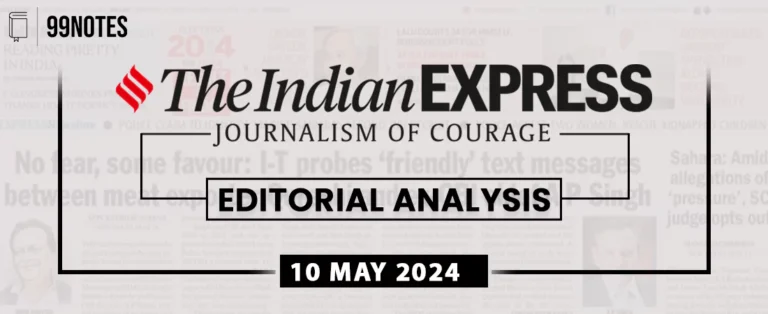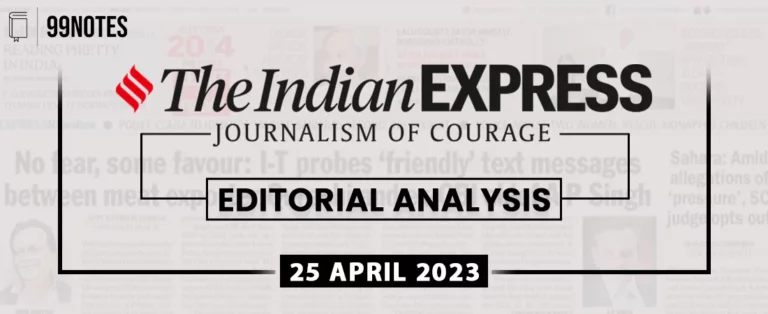17 October 2024 : The Hindu Editorial Analysis
1. Reimagining access to justice
(Source – The Hindu, International Edition – Page No. – 9)
| Topic: GS2 – Indian Polity – Judiciary |
| Context |
|
Introduction to Third-Party Litigation Funding (TPLF)
- A quiet revolution is emerging in India’s legal system, focusing on who pays for justice.
- TPLF offers a solution to individuals and groups who cannot afford litigation costs by bringing in investors to fund cases in exchange for a share of potential winnings.
- This model opens courtroom doors for many who have historically been shut out due to financial constraints.
Real-Life Legal Struggles
- Cases like a small shopkeeper fighting an e-commerce giant or tribal villagers battling polluting industries often fail due to a lack of financial resources.
- TPLF can empower such individuals, ensuring their cases are heard by providing necessary funds for litigation expenses.
- In India, with its backlog of pending cases and expensive litigation, TPLF is seen as a potential solution to make justice more accessible.
Supreme Court’s View and Historical Foundations
- The Supreme Court, in Bar Council of India v. A.K. Balaji, gave a cautious green light to TPLF, as long as lawyers are not involved in financing cases.
- This view is based on the 1876 Privy Council ruling in Ram Coomar Coondoo v. Chunder Canto Mookerjee, which rejected old English champerty laws that barred such funding models in India.
The Ripple Effects of TPLF
- TPLF could impact many areas, from consumer rights in Mumbai to tribal groups in Odisha and tech startups in Bengaluru.
- It has the potential to boost Public Interest Litigation (PIL), medical malpractice cases, and intellectual property rights (IPR) disputes, where expert testimony is often critical.
- The idea behind TPLF is to ensure that financial barriers do not silence cases with merit.
Criticisms and Challenges of TPLF
- Critics argue that funders may only back the most profitable cases, ignoring socially significant but less lucrative claims.
- Another concern is the level of influence funders could exert over case strategy, potentially undermining the independence of the legal process.
- These issues highlight the need for a carefully regulated framework to ensure ethical behaviour and fairness.
Current State of TPLF in India
- Some states, including Maharashtra, Madhya Pradesh, Odisha, and Gujarat, have acknowledged TPLF by amending their civil procedure codes.
- However, India lacks a comprehensive national regulatory framework for TPLF, which is crucial to ensure funders are financially sound, transparent, and ethical.
- A regulatory system should protect clients’ rights, limit funders’ profits, and maintain a balance between access to justice and judicial integrity.
Regulatory Considerations
- One key question is whether litigation funders should be licensed as financial service providers.
- Establishing an oversight body to regulate TPLF and monitor funders is essential for the framework’s success.
- Capital adequacy, similar to Hong Kong’s Code of Practice for Third Party Funding in Arbitration, needs to be addressed, including disclosure of financing details and control by funders.
Role of Courts in TPLF
- Determining the role of courts in TPLF arrangements is another crucial issue, with questions on the level of court involvement and approval needed in such cases.
- Courts must strike a balance between allowing access to justice and preserving judicial integrity.
Conclusion
- TPLF presents both challenges and opportunities for India’s legal system.
- With well-designed regulations tailored to India’s legal landscape, the country could foster a thriving legal funding ecosystem while protecting all parties involved.
| Practice Question: Discuss the potential benefits and challenges of Third-Party Litigation Funding (TPLF) in enhancing access to justice in India.(150 Words /10 marks) |
2. India’s 2024 Global Hunger Index ranking is a matter of concern
(Source – The Hindu, International Edition – Page No. – 8)
| Topic: GS2 – Social Justice – Issues relating to poverty and hunger |
| Context |
|
India’s Hunger Crisis in 2024
Undernourishment in India:
- The 2024 Global Hunger Index (GHI) reveals that 14% of India’s population, around 200 million people, are undernourished.
- This number is comparable to the population of Brazil and ranks as the seventh-largest population globally if considered separately.
GHI Ranking and India’s Economy:
- India ranks 105th with a GHI score of 27.3, placing it in the “serious” category.
- Despite being the fastest-growing economy with a GDP of nearly $4 trillion, wide income inequality and rising food inflation have worsened food accessibility for the poor.
Food Production and Climate Change:
- While India produced a record 332 million tonnes of food in 2023-24, extreme weather severely affected pulses and vegetables.
- This points to climate change’s impact on food security, an issue largely unaddressed by India’s policies.
Health Indicators and Inequality:
- High infant mortality (26 per 1,000 live births) and alarming child stunting (35.5%) and wasting (18.7%) rates highlight the failure of healthcare and social safety nets.
- These indicators underscore the urgent need for systemic reforms to address undernutrition and food insecurity amidst rising inequalities and environmental challenges.
| Global Hunger Index (GHI) |
|
| PYQ: How far do you agree with the view that the focus on lack or availability of food as the main cause of hunger takes the attention away from ineffective human development policies in India? (250 words/15m) (UPSC CSE (M) GS-2 2018) |
| Practice Question: Critically examine the factors contributing to India’s poor ranking in the 2024 Global Hunger Index. How do economic inequality and climate change impact the country’s food security and health outcomes? (150 Words /10 marks) |




